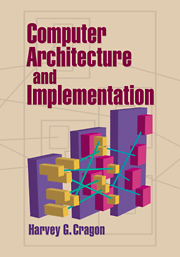
-
Select format
-
- Publisher:
- Cambridge University Press
- Publication date:
- 05 June 2012
- 13 February 2000
- ISBN:
- 9781139164412
- 9780521651684
- 9780521657051
- Dimensions:
- (253 x 177 mm)
- Weight & Pages:
- 0.725kg, 330 Pages
- Dimensions:
- (253 x 177 mm)
- Weight & Pages:
- 0.573kg, 332 Pages
You may already have access via personal or institutional login
Book description
This textbook provides a clear and concise introduction to computer architecture and implementation. Two important themes are interwoven throughout the book. The first is an overview of the major concepts and design philosophies of computer architecture and organization. The second is the early introduction and use of analytic modeling of computer performance. The author begins by describing the classic von Neumann architecture, and then presents in detail a number of performance models and evaluation techniques. He goes on to cover user instruction set design, including RISC architecture. A unique feature of the book is its memory-centric approach - memory systems are discussed before processor implementations. The author also deals with pipelined processors, input/output techniques, queuing modes, and extended instruction set architectures. Each topic is illustrated with reference to actual IBM and Intel architectures. The book contains many worked examples and over 130 homework exercises. It is an ideal textbook for a one-semester undergraduate course in computer architecture and implementation.
Reviews
‘… it is of considerable value to electrical engineers wishing to understand the innards of computers’.
Alex Shafarenko Source: Engineering Management
‘… this is a good book and would make a useful addition to more traditional computer architecture textbooks. Cragon’s writing style is accessible and is bolstered by useful context-enhancing ‘nuggets’ of background information scattered throughout the book.’
Fraser Dickin Source: Measurement, Science and Technology
Contents
Metrics
Altmetric attention score
Full text views
Full text views help Loading metrics...
Loading metrics...
* Views captured on Cambridge Core between #date#. This data will be updated every 24 hours.
Usage data cannot currently be displayed.
Accessibility standard: Unknown
Why this information is here
This section outlines the accessibility features of this content - including support for screen readers, full keyboard navigation and high-contrast display options. This may not be relevant for you.
Accessibility Information
Accessibility compliance for the PDF of this book is currently unknown and may be updated in the future.


